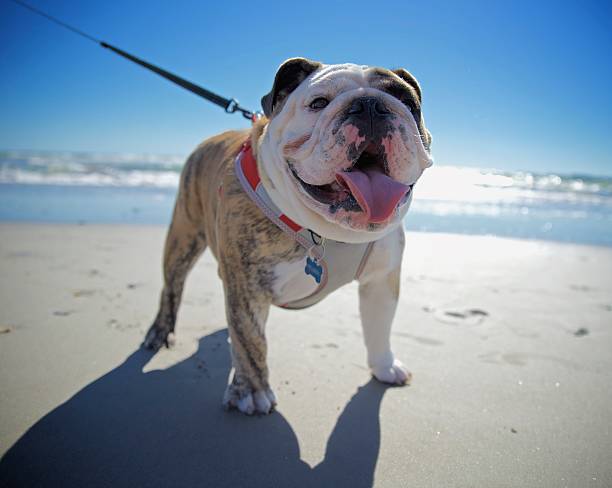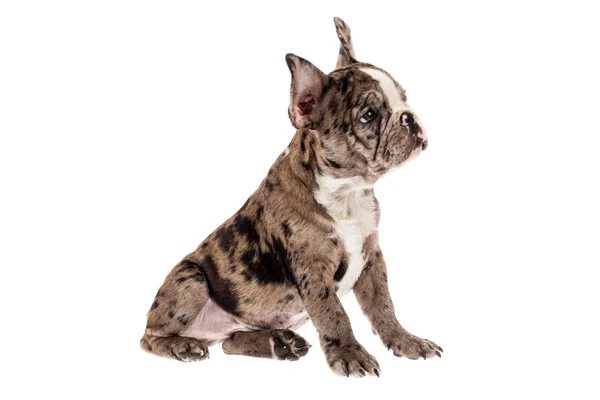The Alapaha Blue Blood Bulldog, an embodiment of strength and courage, holds a special place in the hearts of those who value loyalty and protection. With its striking appearance, protective instincts, and unwavering dedication, this breed has become a cherished guardian and a symbol of Southern heritage.

| Category (Explanation) | Breed Information |
|---|---|
| Year of Breed Conception | 1800s |
| Country of Origin | United States (Southern) |
| Weight (Male) | 75-100 lbs (34-45 kg) |
| Weight (Female) | 60-85 lbs (27-39 kg) |
| Coat Type | Short, stiff, and coarse |
| Color Variations | Blue merle, black merle, brown merle, and more |
| Shedding Level (Low, Moderate, High) | Moderate |
| Height (cm & in) | 18-26 inches (46-66 cm) |
| Breed Size | Large |
| Trainability (Low, Moderate, High) | Moderate |
| Mental Needs (Low, Moderate, High) | Moderate |
| Intelligence Level (Low, Moderate, High) | Moderate |
| Energy Level (Low, Moderate, High) | Moderate |
| Agility (Low, Moderate, High) | Moderate |
| Loyalty (Low, Moderate, High) | High |
| Playfulness (Low, Moderate, High) | Moderate |
| Exercise Needs | Regular exercise and playtime |
| Guarding Proficiency (Low, Moderate, High) | High |
| Sociability with Children (Low, Moderate, High) | Moderate |
| Barking Level (Low, Moderate, High) | Moderate |
| Digging Tendency (Low, Moderate, High) | Low |
| Destructive Behavior (Low, Moderate, High) | Low |
| Drooling Level (Low, Moderate, High) | Moderate to high |
| Obedience Level (Low, Moderate, High) | Moderate to high |
| Apartment Friendly (Yes/No) | Yes, with regular exercise |
| Inherent Prey Drive | Low |
| Physical Risk to Others (Low, Moderate, High) | Low |
| Travel Fatality Risk (Low, Moderate, High) | Low |
| Allergen Potential | Low (considered hypoallergenic) |
| Health Concerns (List of Common Health Concerns) | Hip Dysplasia, Skin Issues, Eye Problems |
| Average Life Expectancy (Life Expectancy in Years) | 12-15 years |










































































Woof Mastery is reader supported and our articles may contain affiliate links.
Instead of running third party ads that we have no control of we only use links from high-quality companies we are directly partnered with. Making use of these links come at no cost to you our reader, and in many cases have the extra benefit of discounted rates or sign up bonuses.
If you’re interested you can read more about our affiliate policy here.
We appreciate your support and always insure that the products and services we recommend are high-quality, helpful and relevant to the subject at hand!
The Alapaha Blue Blood Bulldog’s history is deeply rooted in the Southern United States. These dogs are descendants of Bulldogs brought by early European settlers to the Alapaha River region in Georgia. Prized for their strength and versatility, they played vital roles in hunting, herding livestock, and safeguarding properties.
Over time, these Bulldogs interbred with other breeds, including Mastiffs and Bloodhounds, contributing to their distinctive characteristics. The breed became an integral part of Southern life, aiding settlers in establishing their homes and livelihoods amidst the challenging conditions of the American South.
Known for their unwavering loyalty and protective instincts, Alapaha Blue Blood Bulldogs evolved into cherished family protectors and symbols of Southern heritage. Today, they continue to embody the resilience and courage of their Southern ancestors, remaining devoted guardians and beloved companions.

What sets the Alapaha Blue Blood Bulldog apart is its unique history and heritage. This breed has roots in the Southern United States, where it was developed as a loyal and protective working dog.
Known for their striking coat patterns and unwavering loyalty, Alapaha Blue Blood Bulldogs are excellent family protectors. Their special quality lies in their strong connection to American history and their role as dedicated guardians, making them truly special.
Alapaha Blue Blood Bulldogs have a history of working as farm and guard dogs. Today, they continue to excel as loyal protectors and family companions.
Alapaha Blue Blood Bulldogs are renowned for being fiercely loyal and protective. They have a strong sense of duty and are known for their courage. While they may be reserved with strangers, they form strong bonds with their families, exhibiting unwavering loyalty and affection.
These dogs are known for their alertness and their natural protective instincts, making them excellent watchdogs. They are highly devoted to their families and are willing to go to great lengths to keep them safe.
Alapaha Blue Blood Bulldogs thrive on a sense of purpose and excel in roles that involve guarding and protecting their loved ones. Their imposing appearance and muscular build further contribute to their role as protectors, but beneath the surface lies a heart of gold, always ready to defend and love their family unconditionally.
Alapaha Blue Blood Bulldogs are recognized for their strong protective instincts. Training and socialization are pivotal to manage these instincts effectively and prevent overprotectiveness or aggression towards strangers.
While their protective nature is evident, they often show great devotion and loyalty to their families. Territorial behavior and occasional stubbornness can be addressed through consistent and patient training methods.
Due to their strength and size, leash training is essential for control. Careful introductions are recommended when socializing with other dogs, particularly those of the same sex. Early training and socialization are fundamental to nurturing a well-adjusted and protective temperament in this breed.
Alapaha Blue Blood Bulldogs are known for their vigilance and dedication, making them reliable protectors and loving companions.
Alapaha Blue Blood Bulldogs, often referred to as Alapahas, are medium-sized dogs with a strong and athletic build. They feature a square-shaped head with a broad, well-defined jaw and powerful cheeks, giving them a confident and watchful expression.
Their eyes are typically round and come in various colors. Ears may be natural or cropped, based on individual preference. These dogs have a short, dense coat that can have various colors, often with striking merle patterns.
This coat not only enhances their muscular and athletic physique but also adds to their striking appearance. Alapaha Bulldogs possess a muscular neck, leading to a broad chest and sturdy, straight legs. Their tail is typically straight or may have a slight curve.
In terms of size, males typically stand between 20 to 24 inches (51-61 cm) at the shoulder, while females are slightly smaller. Weight ranges from 70 to 90 pounds (32-41 kg) for males, with females being lighter.
Overall, Alapaha Blue Blood Bulldogs project a confident and watchful presence. They have a history as protective and loyal guardians, and their appearance exudes strength, vigilance, and a devoted temperament, making them an excellent choice for families seeking a protective and loving companion.
Alapaha Blue Blood Bulldogs display several color variations that contribute to their strong and athletic appearance. The most common color varieties include:
Alapaha Blue Blood Bulldogs have a moderate shedding level. While they are not heavy shedders, shedding can occur year-round, and it may increase during certain seasons. Regular grooming, including brushing with a bristle brush or a deshedding tool once or twice a week, can help keep shedding in check and promote a healthier coat.
Factors that can affect shedding in Alapaha Blue Blood Bulldogs can be influenced by genetics and climate. Providing adequate shelter and protection from extreme weather conditions can help manage shedding. Proper nutrition also plays a role in coat health and shedding control.
Alapaha Blue Blood Bulldogs have short, dense coats that are relatively low-maintenance.
Brushing: Regular brushing once or twice a week helps reduce shedding and keeps their coat in good condition.
Bathing: Bathe them as needed, but avoid frequent baths to prevent skin issues. Use a mild dog shampoo and ensure thorough rinsing and drying.
Ears: Clean their ears regularly to prevent wax buildup or infections. Use a damp cotton ball or a veterinarian-recommended ear cleaning solution.
Nails: Keep their nails trimmed to a comfortable length to prevent discomfort.
Teeth: Brush their teeth regularly to maintain good oral hygiene and prevent dental issues. Dental chews or toys can be beneficial.
Wrinkle Care (if applicable): If your Alapaha Blue Blood Bulldog has wrinkles, ensure they are clean and dry between the folds to prevent skin problems. Gently clean and dry as needed.
Eye Care: Keep an eye on their eyes for signs of irritation or discharge. Clean around the eye area if necessary with a damp cloth.
Alapaha Blue Blood Bulldogs have a moderate activity level. They are known for their protective nature. Here are some key points to consider about their activity level:
Alapaha Blue Blood Bulldogs possess a moderate level of intelligence, complemented by their formidable strength and protective instincts. Their intelligence unfolds through various facets:
Alapaha Blue Blood Bulldogs may not excel in problem-solving or obedience rankings, but their intelligence, paired with their unwavering loyalty and protective instincts, makes them reliable family pets and guardians. They have a strong sense of duty to their loved ones and are always prepared to watch over and safeguard them. Proper training and socialization are essential for their well-rounded behavior.
Alapaha Blue Blood Bulldogs have an alert mind. Engage them with puzzle toys, training exercises, or interactive games to stimulate their intellect.
Social Interaction: They are loyal to their families and need consistent human interaction to feel content and avoid feelings of isolation.
Exercise: Regular physical activity, whether it’s playtime in the yard or walks, helps keep their mind alert and reduces any potential behavioral issues.
Training and Obedience: Engaging them in obedience training using positive reinforcement techniques can enhance their relationship with their owner and channel their energy positively.
Routine and Structure: Alapahas appreciate a structured environment. Regular feeding, play, and rest schedules are beneficial for their mental health.
Affection and Attention: They are protective and thrive on the love and attention given by their family.
Socialization: Early exposure to various situations and beings ensures they are well-rounded and confident dogs.
Safe Environment: A secure and comfortable home environment ensures they can relax without feeling threatened or anxious.
Consistency: Maintaining a consistent daily routine and training approach ensures they remain balanced and content.
Enter The Woof Mastery

Before welcoming an Alapaha Blue Blood Bulldog into your home, it’s crucial to recognize their needs. These dogs are known for their protective instincts and loyalty. They require regular exercise and mental stimulation to thrive. Training and socialization are vital to harness their protective nature. Be prepared for potential health concerns like hip dysplasia.
Grooming requirements are relatively low. Responsible ownership involves providing ample love, attention, and a secure environment to ensure the well-being of these loyal and energetic companions.
Alapaha Blue Blood Bulldogs, known for their guarding instincts, have the potential to pose a physical danger if not correctly socialized, trained, or managed. A dog’s behavior is influenced by factors like temperament, upbringing, training, and owner responsibility. Here’s their potential danger breakdown:
Alapaha Blue Blood Bulldogs are renowned for being fiercely loyal and protective. They have a strong sense of duty and are known for their courage. While they may be reserved with strangers, they form strong bonds with their families, exhibiting unwavering loyalty and affection.
These dogs are known for their alertness and their natural protective instincts, making them excellent watchdogs. They are highly devoted to their families and are willing to go to great lengths to keep them safe.
Alapaha Blue Blood Bulldogs thrive on a sense of purpose and excel in roles that involve guarding and protecting their loved ones. Their imposing appearance and muscular build further contribute to their role as protectors, but beneath the surface lies a heart of gold, always ready to defend and love their family unconditionally.
The Alapaha Blue Blood Bulldog, known for its loyalty and protective nature, has certain physical characteristics that affect its swimming abilities. Here are some factors to consider:
Although some Alapaha Blue Blood Bulldogs might show a liking for water and can swim, always evaluate your individual dog’s abilities and comfort before letting them take a dip.
Alapaha Blue Blood Bulldogs, like their peers, have their own set of vocalizations they use to communicate. Here’s a breakdown of the sounds one might expect:
For owners of Alapaha Blue Blood Bulldogs, discerning their dog’s sounds and understanding the context is crucial. While many of these vocalizations are just expressions of their character, others could signify discomfort or specific needs. Employing positive reinforcement can be useful in managing their vocal tendencies.
Alapaha Blue Blood Bulldogs thrive in homes where they receive love, attention, and a structured environment. Here are some ideal living conditions for Alapaha Blue Blood Bulldogs:
Challenges:
When it comes to travel fatality risk for Alapaha Blue Blood Bulldogs, consider the following potential constraints specific to this breed:
By addressing these potential constraints and taking necessary precautions, you can help ensure the safe travel of your Alapaha Blue Blood Bulldog and minimize travel-related risks.
Alapaha Blue Blood Bulldogs may be prone to specific health concerns. While not all individuals will experience these issues, it’s essential for Alapaha Blue Blood Bulldog owners to be aware of potential health problems and work with veterinarians to maintain their pets’ well-being. Common health concerns for this breed include:
By ensuring regular veterinary check-ups, a well-balanced diet, and consistent exercise, the Alapaha Blue Blood Bulldog’s health can be optimally maintained. A close bond with a reliable veterinarian is crucial for this breed’s well-being.
Proper nutrition is crucial for the health and well-being of Alapaha Blue Blood Bulldogs. Here are some nutritional habits and best practices to consider for this breed:
By following these nutritional best practices and working closely with your veterinarian, you can ensure that your Alapaha Blue Blood Bulldog enjoys a healthy and active life.
Breed-Specific Laws (BSL): Alapaha Blue Blood Bulldogs might occasionally come under breed-specific laws (BSL), especially in regions unfamiliar with this rarer breed and its characteristics.
Types of Restrictions: These can include mandatory spaying/neutering, distinct licensing procedures, requisite liability insurance, muzzling mandates in public areas, and occasionally, ownership restrictions.
Rationale for BSL: Generally implemented due to safety concerns linked to certain breeds, Alapahas, though protective, aren’t inherently aggressive, yet they may be mistakenly included.
Controversy: The merit and efficiency of BSL are widely debated, with many suggesting that dog behavior and ownership quality should be the focus.
Local Regulations: Prior to deciding on an Alapaha Blue Blood Bulldog, it’s crucial to familiarize oneself with any local breed-based restrictions.
Woof Mastery is reader supported and our articles may contain affiliate links.
Instead of running third party ads that we have no control of we only use links from high-quality companies we are directly partnered with. Making use of these links come at no cost to you our reader, and in many cases have the extra benefit of discounted rates or sign up bonuses.
If you’re interested you can read more about our affiliate policy here.
We appreciate your support and always insure that the products and services we recommend are high-quality, helpful and relevant to the subject at hand!
Myth 1: Alapaha Blue Blood Bulldogs are Aggressive by Nature
Myth 2: They Are Always Good Guard Dogs
Myth 3: They Are Not Good with Children
Myth 4: They Can’t Live in Apartments
Myth 5: They Are All the Same Size
Myth 6: They Don’t Require Training
Myth 7: They Are Lazy Dogs
Myth 8: They Are Unhealthy Dogs
Myth 9: They Can’t Tolerate Cold Weather
Myth 10: They Don’t Get Along with Other Dogs
The Alapaha Blue Blood Bulldog holds cultural significance in various contexts:
While there may not be as many famous Alapaha Blue Blood Bulldog owners as there are for other dog breeds, here are a few notable individuals who have been associated with Alapaha Blue Blood Bulldogs:
Alapaha Blue Blood Bulldogs, like many other dog breeds, have faced several threats and challenges over the years. Some of the significant threats and issues that have affected the breed include:
The Alapaha Blue Blood Bulldog is believed to have been developed from a combination of various breeds, with the primary ancestors being the now extinct southern breeds of the American Southeast. The breed’s development occurred mainly in Georgia, USA, with influences from regional strains and breed types. The specific breeds and strains that contributed to the Alapaha Blue Blood Bulldog’s development include:
Alapaha Blue Blood Bulldogs are guardians with a heart of gold. Their imposing stature and protective instincts make them excellent watchdogs and loyal protectors of their homes. These dogs are known for their adaptability, thriving in various living conditions, and requiring only minimal grooming.
While they may appear imposing, they are gentle and patient with their families, making them perfect companions for children. Alapaha Blue Blood Bulldogs’ intelligence and trainability shine, allowing them to excel in various activities and roles. Their steadfast loyalty and unwavering devotion are unmatched, and they take their role as family protectors seriously.
Beyond their protective nature, they bring a unique charm to every household, filling it with their loving presence. These versatile dogs effortlessly transition from family pets to dedicated working dogs.
Above all, they offer profound and unconditional love, becoming cherished family members who enrich lives with their unwavering companionship. Embrace the extraordinary love and dedication of an Alapaha Blue Blood Bulldog and make them an integral part of your life.